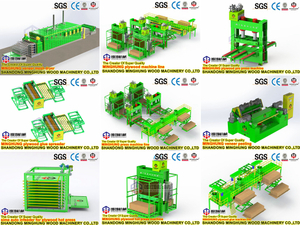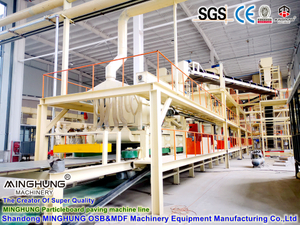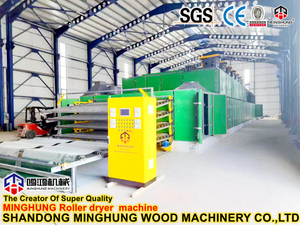What is the Plywood and How to produce Plywood?
1. The basic concept of plywood
Plywood - Cut logs into veneers or slice them into veneers, then use glue as an adhesive to lay the veneer into three or more layers, depending on the thickness of the plywood required.
2. Advantages of plywood
(1) Save wood. For wood with a diameter of 17CM or more, every 2.2-2.5M3 wood can produce 1M3 plywood, which can be used instead of 5M3 log sawn timber. Wood with a diameter of 8-16CM can be peeled by a card-free rotary cutter to produce solid wood composite flooring substrates, LVL and other products
(2) Overcome the natural defects of wood. The structure of wood itself causes disadvantages such as uneven quality, anisotropy in different directions, low absolute value of mechanical strength, and shrinkage of wet tents. However, the artificial processing method of plywood has changed these defects, achieved special performance requirements, and has a wide range of uses. Plywood is commonly used in construction, furniture, packaging, shipbuilding, aviation, etc.
3. Classification of plywood
There are many classification methods, such as tree species, glue types, structure and use.
Classified according to the type of glue and water resistance: weather-resistant, boiling water-resistant plywood, water-resistant plywood, moisture-resistant plywood, non-moisture-resistant plywood
According to the classification: building formwork, furniture board, packaging board, decorative plywood, solid wood composite floor substrate, laminated veneer lumber
4. The composition principle of plywood
Wood is anisotropic. In order to eliminate the inherent shortcomings of wood, the following principles should be followed when veneer is composed of plywood:
(1) Principle of symmetry - The veneers on both sides of the symmetrical center plane should correspond to each other regardless of tree species, veneer thickness, number of layers, manufacturing method, fiber direction, veneer moisture content, etc.
(2) The principle of odd number of layers - since the structure of plywood is the fiber direction of adjacent veneers, which are perpendicular to each other and must conform to the principle of symmetry, the total number of layers must be odd. For plywood with an odd number of layers, the center plane of symmetry coincides with the symmetry plane of the core board of the middle layer
(3) The principle of the thickness of veneer layers - Plywood of the same thickness can be composed of thicker veneer with fewer layers; it can also be formed with thinner veneer with more layers. When the plywood thickness is constant, it is related to the number of layers. In actual production, although the thinner the veneer is, the higher the quality of the plywood is, but the processing is more difficult. And the production cost increases, so the thickness principle must make an appropriate choice according to the use of the product
How to produce plywood? what is the production process? what machines are required?
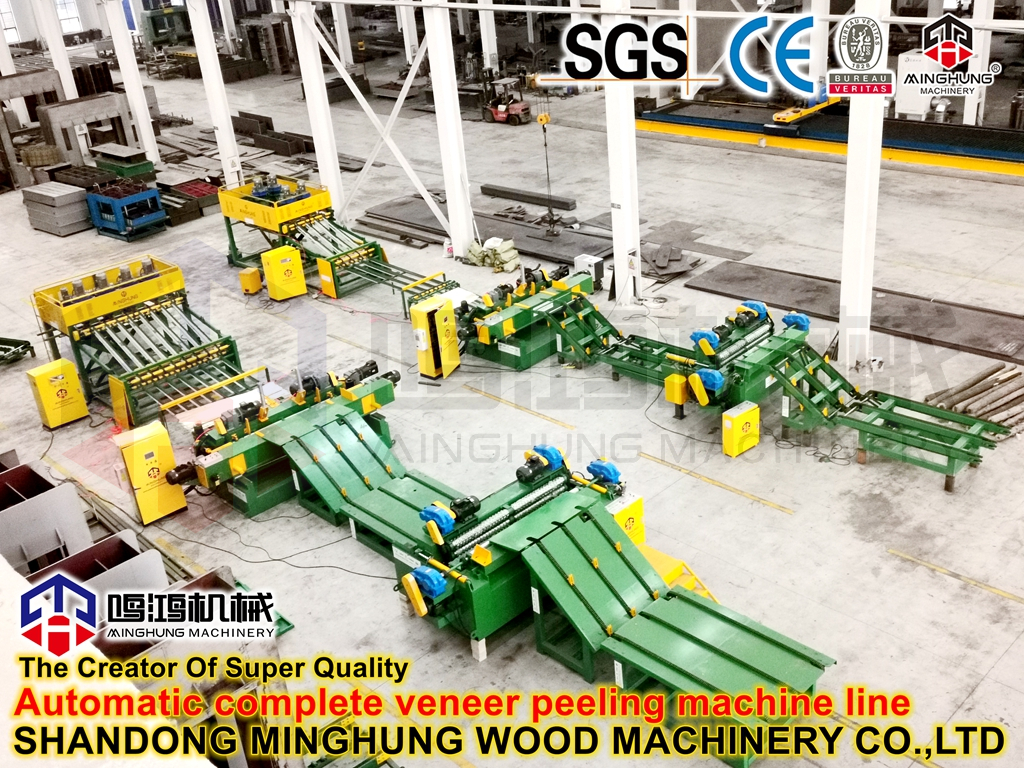
Veneer peeling line
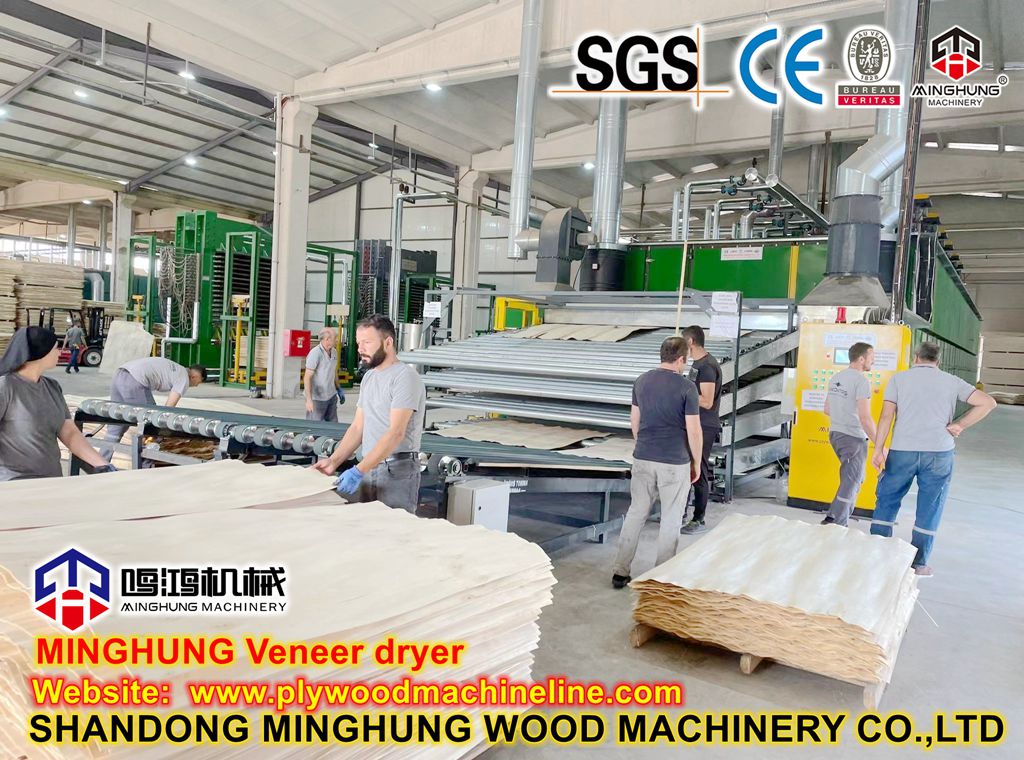
Veneer Drying line
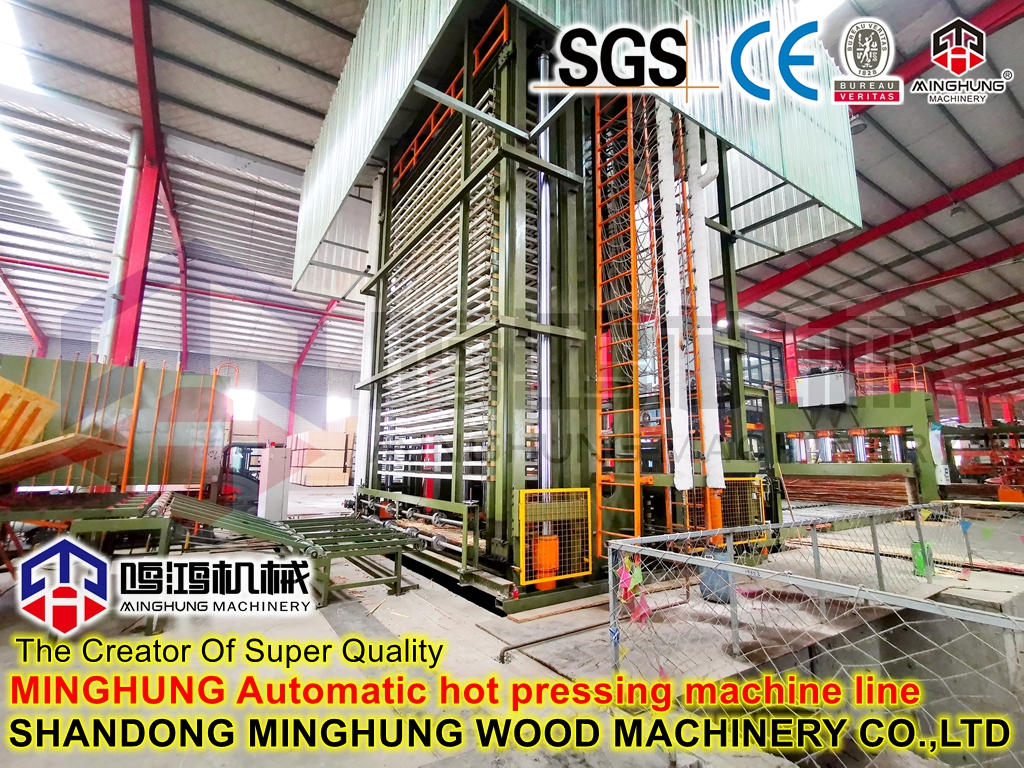
Automatic hot press machine
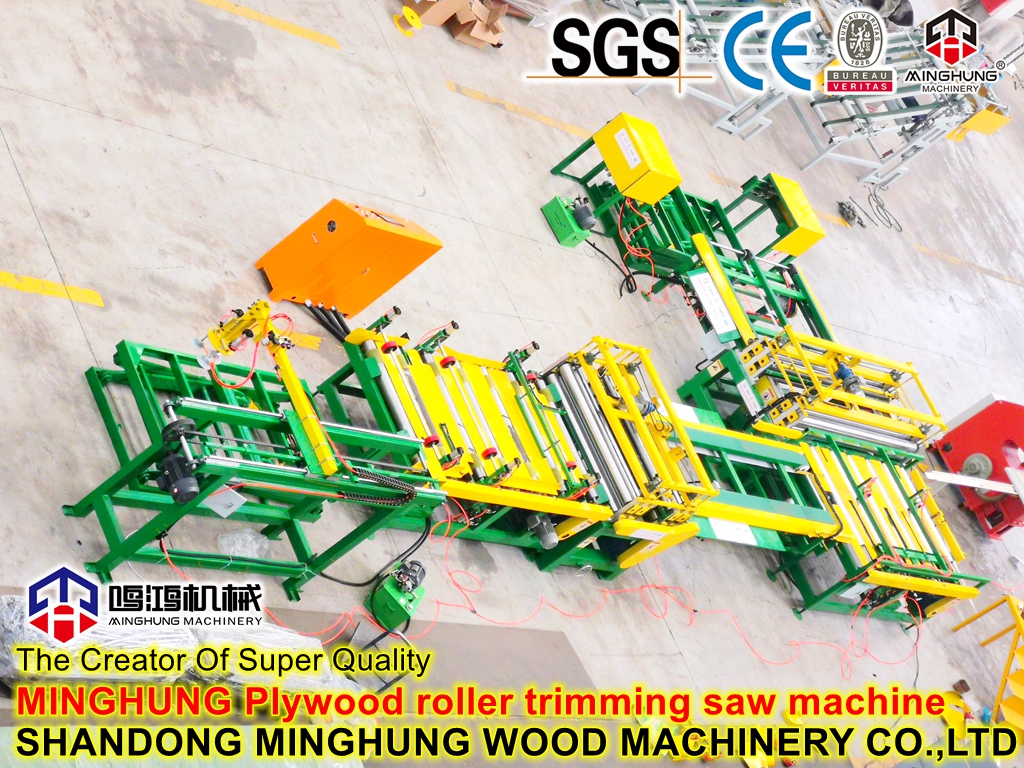
Plywood roller edge trimming saw
The production methods of plywood are generally divided into hot and humid method, cold and dry method and hot and dry method. Dry and wet refers to whether the veneer used in glue pressing is dry or wet. Cold and hot refers to hot pressing or cold pressing bonding.
At present, the joint plate produced by domestic and foreign enterprises is commonly produced by dry heat.
Log → log sawing → wood section peeling → veneer rotary cutting → veneer drying → veneer finishing → rubber coating → blank assembly → prepressing → hot pressing → edge cutting → sanding → inspection grading → Packing and storage.
Plywood production process control:
Before gluing, we should pay attention to the sizing and aging of the two links. Both theory and practice have proved that too high or too low sizing amount is not good for bonding strength. The sizing amount is too large, the glue layer is too thick, the internal stress increases, it is easy to penetrate the glue, and the production cost increases; Sizing amount is too small, is not conducive to glue infiltration, glue layer will be incomplete. In addition, when applying glue, the glue liquid on the surface of the core plate should be evenly distributed, and the lack of glue or excessive glue liquid on the back should not occur. The quality of the veneer and the quality of the rubber roller affect the distribution uniformity of the glue. When the veneer is coated, the whole length direction of the rubber roll should be used. Only a certain section of the rubber roll should be avoided, otherwise it will wear the back of the rubber roll and affect the quality of the rubber.
The aging time of coated veneer should be controlled. Too short time aging can not reach the purpose of aging, in the preloading will not be satisfactory preloading effect. A long time of aging will make the glue liquid into the veneer and cause the lack of glue on the surface. At the same time, the accumulation heat during the aging of the veneer will lead to premature solidification of the adhesive layer. The length of aging time should vary reasonably with the climate, shorter in summer and longer in winter. Henan Jianjie production of industrial flour instead of powder, has been widely used in the market.
Hot pressing to control the moisture content of the slab, hot pressing temperature, pressure and time. The temperature is mainly determined by the type of glue used, the pressure is determined by the type of tree, the type of product and the structure of the plywood, etc., and the time is determined by the thickness of the product and the type of glue, etc. In the process of hot pressing, the depressurization speed must be controlled well, especially when pressing thick plywood and high moisture content slab, especially when controlling the depressurization speed, otherwise it is easy to produce bubbling problem.
In addition, the use of new technology, new equipment, such as the use of high efficiency jet veneer dryer, core board sewing machine, core board leveling equipment, to achieve the glue coating, billet formation, prepressing and hot pressing continuous operation, the use of mechanical loading and unloading board system, rapid closing device, can accurately control the process conditions, so that the product quality is more guaranteed.
Matters need attention:
Sizing equipment: according to the state of adhesive, it is divided into dry sizing and liquid sizing. Dry sizing requires high smoothness of veneer and is rarely used in China.
Liquid sizing roller coating, spray sizing, extrusion sizing, spraying sizing. Domestic commonly used roller coating. The rubber coating roller has four roller coating machine, two roller coating machine, etc. More rolls of glue can be increased, less to the right amount.
② Requirements of veneer: The thickness of veneer is different, and the absorption amount of adhesive liquid is different. The thicker the infiltrated glue, the rougher the veneer surface, the deeper the cracks on the back, the larger the sizing amount is required.
(3) Preloading requirements: slab height: 1m, surface pressure: 0.8~1.0MPa, preloading time: 15~20min.
Preloading effect: When the veneer is opened, the adhesive layer has a slightly drawn phenomenon for good bonding (note that the drawing cannot occur when the adhesive is coated). Preloading effect needs to increase the initial viscosity, such as urea formaldehyde resin can be added to some polyvinyl alcohol, usually processing industrial flour.
④ Hot pressing requirements: ordinary plywood 0.8~1.5MPa; Aviation plywood 2.0~2.5MPa; Ship plywood 3.5~4.0MPa; Wood laminated plastic 15MPa. The size of the hot pressing pressure depends on the type of tree, the type of rubber and the different requirements for the product. Hard broadleaved wood requires slightly more pressure than soft broadleaved wood, and less fluid rubber seeds require slightly more pressure than more fluid rubber seeds. Engineering structure plywood such as aviation plywood has higher requirements for strength, the unit pressure is larger; The ordinary plywood used for decoration does not require high strength, and a lower unit pressure is usually used to save wood. In addition, the process parameters such as water content, hot pressing temperature and sizing amount of slab have certain influence on the determination of hot pressing pressure. Higher water content of the slab, plasticity is better, the pressure can be smaller. High pressure is required for low sizing. In order to make the wood and adhesive interface between good contact. Hot pressing temperature is high, wood plasticity is good, the required pressure can be small. However, too high temperature of hot pressing plate will make the adhesive on the surface of slab solidify rapidly, but will produce resistance to compression. Therefore, it is necessary to consider the curing speed of adhesive and select the best hot pressing temperature to minimize the pressure resistance.
Hot pressing temperature of protein glue: 95~120℃, urea-formaldehyde resin glue 105~120℃, phenolic resin glue 130~150℃.
Hot pressing time should consider the time required for heating the edge of rubber layer farthest from the pressing plate. The pressure holding time depends on the thickness of the finished plywood. For example, the thickness of the finished plywood is 1mm 40s, and the thickness of the finished plywood is over 5 layers. The pressure holding time of the finished plywood is 1min for each thickness of 1mm.
We are China factory who manufacture all plywood equipment from the materials to the end product, we can offer you all required machine, and make sure machine is suitable, good and strong, like veneer peeling machine, veneer drying machine, plywood assembly machine, veneer sewing machine, glue machine, pre-press machine, hot press machine, plywood edge trimming saw, sanding machine and others
Welcome contact us for more information about machines, we will offer you machine working videos with you, and offer specification according to your own conditions
Contacts:
Mark: +8618769900191
Ali: +8615805496117
Lucinda: +8615805493072
Email: minghungmachinery@gmail.com





